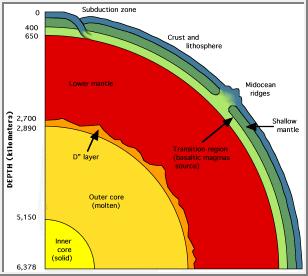Earth's Interior

The center of the Earth is called the Inner Core. It is found at a depth of 5,150-6,370 km, as shown in the diagram above. It is composed of solid iron and nickel. It is suspended in the center of the Outer Core and it is believed to have formed as a result of pressure-freezing which occurs to most liquids when they are under extreme pressure.
The next layer, the Outer Core, is made up of a hot, electrically conducting liquid (mainly iron and nickel). This layer combined with the Earth's rotation creates a dynamo effect which maintains the electrical field which surrounds the Earth.
The D" layer is often identified as part of the Lower Mantle, but seismic evidence suggests that it may be chemically different. It is possible that it is comprised of material from the Lower Mantle which has dissolved in the core, or is material which has sunk through the core but has been stopped at the core-mantle-boundary, unable to sink any further, because of its density.
The Lower Mantle is composed of silicon, magnesium and oxygen, and probably iron, calcium and aluminium.
Between the Lower and Upper Mantles is the Transition Region. This area is the source of basaltic magmas. It contains calcium, aluminium and garnet. At low temperatures this layer is dense because of the garnet, but when it is hot the layer is bouyant as the minerals can melt easily to form basalt which then rises through the upper layers as magma.
Parts of the Upper Mantle have been found in eroded mountain beds and were found to contain Olivine and Pyroxenes. These and other minerals are crystalline at very high temperatures, therefore part of the Upper Mantle may be partially molten.
The final layer is the crust. Its thickness depends on whether it is oceanic or continental crust.
Oceanic crust is 0-10 km thick and is made by volcanic activity at oceanic ridges. Oceanic ridges generate new crust at a very fast rate (17 km3 per year). The ocean floor is covered with Basalt. Hawaii and Iceland are two examples of Basalt islands.
Continental Crust is 0-75 km thick and is composed of crystalline rocks, mainly Quartz and Feldspars.
Evidence for the Internal Structure of the Earth
all images used on this page from www.moorlandschool.co.uk